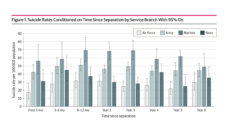How to use a new policy statement to guide your suicide prevention advocacy efforts
Suicide is preventable. This adage has been used for years as a rallying cry by suicide preventionists to inspire the public to take action against America’s tenth leading cause of death. And yet, when confronted with the question of how to prevent suicide, the answer remains cloudy for most.
Recognizing the need for improved guidance on how to move the field of suicide prevention forward, public health experts from around the country convened in 2021 in support of a common goal– to develop a detailed policy statement to guide advocacy. The group was successful. In October, the American Public Health Association formally adopted “A Comprehensive Approach to Suicide Prevention within a Public Health Framework.” The statement is a tool activists can use to advocate for increased support for suicide prevention efforts within their communities, organizations, and states. Here is how you can use it:
Educate yourself. The policy statement begins with an overview of scientific evidence to challenge longstanding myths regarding suicide risk factors. The most notable myth suggests suicide is solely the result of a mental health crisis and can be solved within the confines of a health care setting. Data shows that suicidality is the result of a complex confluence of factors. Across the lifespan, factors at multiple levels of influence can all play a part, including early life adversity, social connectedness, access to lethal means, and structural racism and discrimination.
As such, we must move away from the idea that suicidality appears within a provider’s office among “at risk” patients. Instead, we need to embrace an approach that, in the words of the policy statement, “explores how the environment has put them at greater risk in the first place.” It is critical to equip suicide prevention advocates with accurate facts.
In sum, suicide is preventable. It just might take a new approach.
Educate others. APHA encourages community members to use the policy statement to inform fact sheets, infographics, and other educational materials to distribute within their networks and organizations. If you have the opportunity to speak up for suicide prevention in any setting, consider using the statement as a starting point for developing your materials and talking points.
Inform your vote. The policy statement presents a comprehensive list of specific causes of suicide risk in the U.S. accompanied by a list of action steps. Many of the actions steps are rooted in policy. To prevent suicide, our national, state, territorial, Tribal and local public health agencies, health departments, and healthcare systems need funding to develop, expand, and/or maintain surveillance data systems, public health messaging campaigns, and a diverse body of professionals trained in evidence-based, culturally sensitive, trauma-informed care.
Policies that support strategies to reduce access to lethal means are also urgently needed to protect people at risk for suicide and promote firearm safety. When elections are underway, review the action steps noted in this policy statement, and align your votes with the people and policies that support these priorities.
Prepare for pushback. Conflict is innate to advocacy. When advocating for increased focus and/or funding to support suicide prevention, you will undoubtedly encounter detractors. The policy statement contains “opposing arguments” that anticipate potential points of contention and provide evidence-based counterpoints. Studying the viewpoint of the opposition can improve your ability to engage in productive negotiations.
In sum, suicide is preventable. It just might take a new approach.
If you or someone you know if struggling with suicidal thoughts, you are not alone. You can access the National Suicide Prevention Lifeline any time at 1-800-273-8255 or visit https://suicidepreventionlifeline.org/
You can access the full policy statement here.
The policy statement was sponsored by the Mental Health Section of APHA and was co-sponsored by the Public Health Social Work Section and the Pharmacy Section. We would like to acknowledge the authors of the policy statement: Kristen Quinlan, Kerri Nickerson, MaryJane Alexander, Abigail M. Ross, Lisa C. Flaherty, Robin Kinnard, Erica L. Hamilton, & Julie Kafka.
Photo via Getty Images















